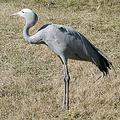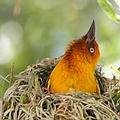 一家英國與南非聯合持股的公司得到許可,將在南非生態最敏感脆弱的自然環境之中開採煤礦,保育人士為此向南非高等法院提出申請,希望對於許可核發過程進行司法審查(judicial review)。
一家英國與南非聯合持股的公司得到許可,將在南非生態最敏感脆弱的自然環境之中開採煤礦,保育人士為此向南非高等法院提出申請,希望對於許可核發過程進行司法審查(judicial review)。
這家名為騰達礦業(Delta Mining)的南非公司,多數股權在10月份仍屬倫敦礦業所有,保育人士認為該公司非法取得探勘權,並且將對南非的自然資產造成極為嚴重的威脅,且影響可長達數十年。
保育人士警告,Pretoria東方面積近2百平方公里的瓦科斯楚-呂納堡(Wakkerstroom/Luneburg)濕地與草原地帶 開採煤礦區域,會造成超過3百種鳥類的棲地遭到摧毀。
可能受到衝擊的包括南非的國鳥—「藍蓑羽鶴 」(A. paradisea)。這種鳥類已被世界自然保育聯盟(IUCN)瀕危物種《紅皮書》列入「易危」(vulnerable)等級。保育人士警告,此地是4條主要河川的源頭,都可能因為採礦活動受到污染。
 在英國皇家鳥類保育協會(RSPB)的支持下,南非鳥盟(BirdLife South Africa)向高等法院申請,對騰達公司在瓦科斯楚-呂納堡地區的探勘權進行司法審查。
在英國皇家鳥類保育協會(RSPB)的支持下,南非鳥盟(BirdLife South Africa)向高等法院申請,對騰達公司在瓦科斯楚-呂納堡地區的探勘權進行司法審查。
鳥盟認為,這些探勘權取得的過程中,不曾適當詢問可能遭受影響的地主,也沒有對採礦的嚴重生態衝擊做出適當考量。對於鳥盟的申請,騰達礦業與南非政府礦產與能源部同表反對。
騰達礦業在2007年8月與11月取得瓦科斯楚-呂納堡地區的探勘權。保育團體指出,探勘權核准過程違反了南非「國家環境管理法」與「礦產石油資源發展法」的部份規定。
這兩項法案都要求對利益持有者與受影響者進行諮詢,包括了地主、南非鳥盟、世界自然基金會南非分部與厄侃嘉拉(Ekangala)草原基金會。
瓦科斯楚地區的高海拔草原棲息了3百種以上的鳥類,以及1百種以上的當地特有植物。在南非的賞鳥旅遊活動中,超過8成將瓦科斯楚列入行程。
受煤礦探勘威脅的地點包括了蓬戈拉(Pongola)森林保育區,是正式受到保護的區域,屬於東部草原的一部份。
騰達礦業在環境管理計畫中宣稱蓬戈拉森林「沒有任何物種受到威脅」,然而保育團體指出,這個草原是南非13種特有鳥類唯一會出現的地區,並在2001年被南非鳥盟選定為重要野鳥棲地(IBA)。
英國皇家鳥會的非洲鳥類專家巴克利(Paul Buckley)表示,「這是南非自然生態未來數十年將面臨的最嚴重威脅。瓦科斯楚是世界知名的生物多樣性熱點,也一直是南非環境最獨特的代表性地點。」
Wildlife conservationists have applied to the South African High Court for a judicial review of permission granted to a British-South African company to mine coal in the core of one of South Africa' most ecologically sensitive natural environments.
Conservationists contend the prospecting rights obtained by Delta Mining, a South African company, majority owned by London Mining as of October, are illegal and pose one of the most serious threats to South Africa's natural heritage for decades.
They warn that extraction of coal from almost 200 square kilometers of the Wakkerstroom/Luneburg region, an area of wetlands and grassland east of Pretoria, would destroy habitats used by over 300 bird species.
One of the species at risk is South Africa's national bird, the blue crane, Grus paradisea, which is listed as Vulnerable to extinction on the IUCN Red List of Threatened Species. The sources of four major rivers are found in the region and all could be polluted by mining operations, the conservationists warn.
BirdLife South Africa, supported by the Royal Society for the Protection of Birds based in the UK, has applied to the South African High Court for the judicial review of Delta's prospecting rights in the Wakkerstroom/Luneburg region.
The groups maintain that these prospecting rights were obtained without proper consultation with affected landowners and without adequately taking the severe conservation impact of mining into consideration.
Their application is being opposed, by both Delta Mining and the South African Government's Department of Minerals and Energy.
Delta Mining was awarded prospecting rights for the Wakkerstroom/Luneburg area in August and November 2007. The conservationists argue that the rights were awarded in violation of sections from the National Environmental Management Act and the Minerals & Petroleum Resources Development Act.
Both laws require consultation with interested and affected parties, which in this case includes landowners and environment groups, such as BirdLife South Africa, WWF—south Africa and the Ekangala Grasslands Trust.
Wakkerstroom's high altitude grasslands host more than 300 species of bird and more than 100 endemic plants, and more than 80 percent of bird-watching trips in South Africa include Wakkerstroom in their schedule.
Among sites threatened by the prospecting is the Pongola Forest Reserve, which is a formally protected area and forms part of the Eastern Grasslands region.
Delta Mining claims in its Environmental Management Plan that there are "no threatened species on the site," yet the conservationists point out that 13 of the country's endemic bird species are found only in this grassland region and this area was designated an Important Bird Area by BirdLife South Africa in 2001.
"This is one of the biggest threats to South Africa's wildlife to emerge for decades," said Paul Buckley, RSPB Africa Specialist. Wakkerstroom is known worldwide as a biodiversity hotspot and has long been a unique environmental showcase for South Africa."


